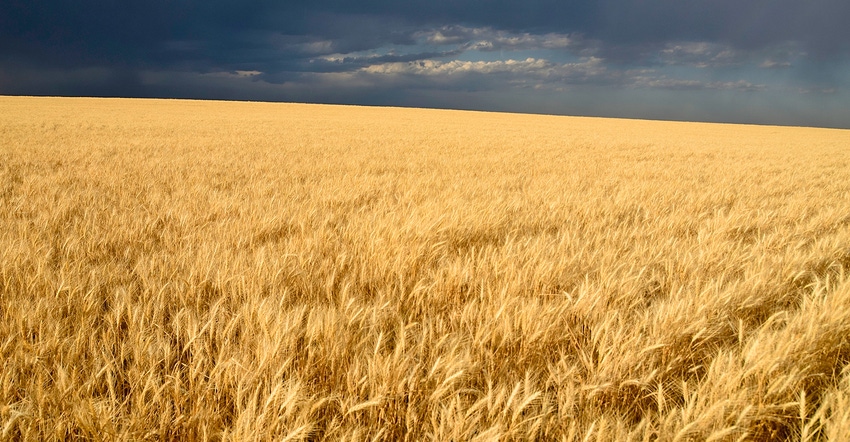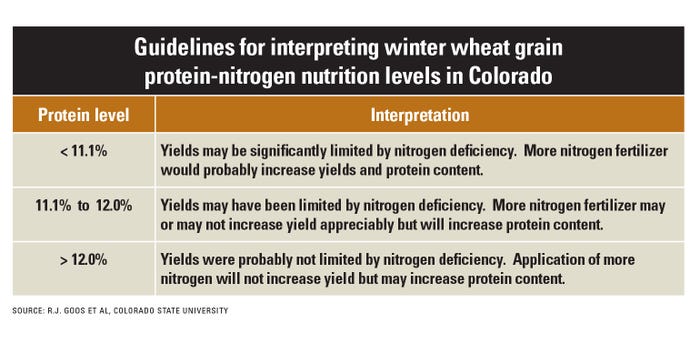May 23, 2019

By Ron F. Meyer
Can we influence protein contents with wheat production management strategies? Many of our wheat fields test low for protein and consequently, price discounts are assessed to wheat loads delivered to elevators.
In the last few years, these discounts have been somewhat large, resulting in significant economic losses. Some seasons, fields that have acceptable protein levels are paid a premium; and as a result, growers are interested in managing wheat fields for better protein levels.
First, research has found that there is an inverse relationship between yield and protein levels. As wheat yields increase, protein levels tend to decrease — especially if fertilizer inputs are not increased with high yields.
Scott Haley, a Colorado State University wheat breeder, explains that “High yields occur as a result of favorable precipitation early, which increases wheat kernel numbers per plant.” More wheat kernels translate into more weight produced (pound per acre) which means higher grain yields.
Wheat kernels contain approximately 65% starch, and this starch content is extremely sensitive to the growing season’s environment at the end of the season. This extra starch produced with high wheat yields essentially “dilutes,” or reduces, protein content.
Wheat kernels contain approximately 8% to 15% protein. Protein levels are a direct function of the amount of nitrogen within the plant during later stages of production. In fact, protein tests made on wheat kernels measure the nitrogen content to determine protein levels.
Protein begins accumulating within kernels during grain fill. Research has found that 10 days after flowering, protein begins to accumulate in kernels. By 20 days after flowering, 50% of protein has been placed into developing kernels. During this time, starch is also being deposited into kernels.
Therefore, growing conditions and adequate nitrogen amounts after wheat plants flower determine protein levels in grain. Excessive heat and drought during this grain filling time period lower the amount of starch deposited into kernels, which increases protein percentages. Better-than-average moisture conditions during grain fill will lower protein percentages.
Nitrogen factors
Can protein levels coming off a wheat field tell us if nitrogen was yield-limiting? CSU researchers found a direct correlation that suggests protein levels in wheat are tied to nitrogen management. As a result, the rule of thumb for nitrogen management is as follows: Wheat fields routinely testing less than 11.5% protein have yield-limiting low levels of nitrogen fertilization; wheat fields that have grain protein levels of 12% or more had enough available nitrogen to reach full yield potential.

Can we fertilize or make a variety selection to influence protein in wheat? Eighty percent of a wheat plant’s nitrogen accumulation is taken up prior to flowering. However, that leaves 20% of a plant’s nitrogen needs taken up after flowering and during grain fill. But, keep in mind that new research is finding varietal differences in nitrogen uptake, which can also affect final protein content.
The term “grain protein deviation” describes higher nitrogen uptake from some wheat varieties versus others. As a result, wheat variety selection can influence protein content when growing conditions cooperate, but nitrogen management remains by far the most effective way to influence protein.
Further, researchers at Oklahoma State University have found that late applications of nitrogen can also increase protein levels in wheat. These researchers applied nitrogen to wheat test plots as late as the flag leaf stage (right before heading) and found that later nitrogen applications increase protein contents. These later applications increased wheat yields only slightly, but increased protein contents more. The application method was liquid nitrogen streamed onto fields.
Higher protein boosts were noted with rainfall received right after nitrogen applications. Protein levels were increased by 0.05% protein content per pound of nitrogen applied. Therefore, it took 20 pounds per acre of actual nitrogen to raise protein levels 1% (plus rainfall after application).
Nitrogen limits
Keep in mind, however, that when applying late-season nitrogen, plants have a limit to how much nitrogen can be taken up. It is expected that nitrogen applied at this point may be able to raise protein levels 1% to 2%. Also, because of later applications, slow-release, low-salt or organic nitrogen forms may not be the best fit.
Similar (and usually better) protein results can be achieved with adequate nitrogen fertilization earlier in the growing season. Many wheat fields are fertilized early in the spring, with herbicide applications or with separate streaming operations. Adequate nitrogen applications at this time of the growing season will increase both yield and protein levels. Normally, adequate fertilization early in the season is the most cost-effective nutrient management strategy.
Soil and plant tissue tests will determine the nitrogen amounts needed. Setting realistic yield goals and knowing current nutrient test levels will keep applications near economic levels.
Keep in mind that yield and economics should drive crop input decisions for each field. Planting varieties that are proven to be adapted to our area, and managing other inputs such as weed and disease issues need to have production priorities first. Protein premiums are not consistent, but there are nitrogen management decisions that can affect protein contents when protein production is profitable.
This article was adapted from Brian Arnall at Oklahoma State University.
Meyer is an area Extension agronomist with Colorado State University.
Source: Colorado State University. The source is solely responsible for the information provided and is wholly owned by the source. Informa Business Media and all its subsidiaries are not responsible for any of the content contained in this information asset.
You May Also Like




